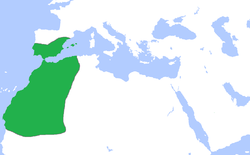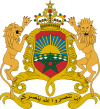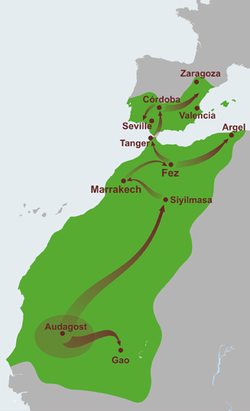- Almoravid dynasty
-
Almoravid dynasty
ⵉⵎⵕⴰⴱⴷⵏ/المرابطون
Al-Murābiṭūn← 
←
1040–1147
 →
→The Almoravid empire (green) at its greatest extent, c. 1120. Capital Aghmat (1040-1062), Marrakech (1062-1147) Language(s) Primarily Berber languages, Andalusian Arabic, Arabic and Classical Arabic.
Religion mainly Islam, with some Catholic and Jewish minorities Government Monarchy Caliph - 1040-1059 Abdallah ibn Yasin - 1146–1147 Ishaq ibn Ali History - Established 1040 - Disestablished 1147 Area - 1147 est. 3,300,000 km2 (1,274,137 sq mi) Currency Dinar Today part of  Algeria
Algeria
 Gibraltar
Gibraltar
 Mali
Mali
 Mauritania
Mauritania
 Morocco
Morocco
 Portugal
Portugal
 Spain
Spain
Western SaharaThe Almoravids (Berber: ⵉⵎⵕⴰⴱⴷⵏ Imṛabḍen, Arabic: المرابطون Al-Murābiṭūn) were a Berber dynasty of Morocco, who formed an empire in the 11th-century that stretched over the western Maghreb and Al-Andalus. Their capital was Marrakesh, a city which they founded in 1062 C.E. The dynasty originated amongst the Lamtuna and the Gudala, which were nomadic Berber tribes of the Sahara traversing the territory between southern Morocco, the Niger river and the Senegal river.[1]
The Almoravids were crucial in avoiding a precipitated fall of Al-Andalus to the Iberian Christian kingdoms, when they decisively beat a coalition of the Castilian and Aragonese armies at the Battle of Sagrajas. This enabled them to control an empire that stretched 3,000 kilometers north to south. However, the rule of the dynasty was relatively short-lived and the Almoravids fell -at the height of their power- when they failed to quell the Masmuda-led rebellion initiated by Ibn Tumart. As a result, their last king Ishaq ibn Ali was killed in Marrakesh in April 1147 C.E. by the Almohads who replaced them as a ruling dynasty both in Morocco and Al-Andalus.
Contents
Name
The term "Almoravid" comes from the Arabic "al-Murabitun" (المرابطون) which is the plural form of "al-Murabit" literally meaning "One who is tying" but figuratively means "one who is ready for battle at a fortress". The term is related to the notion of Ribat, a frontier monastery-fortress, through the root r-b-t (ربط "Rabat": to tie or رابط "Raabat": to encamp).[2][3]
It is uncertain exactly when or why the Almoravids acquired that appellation. al-Bakri, writing in 1068, before their apogee, already calls them the al-Murabitun, but does not clarify the reasons for it. Writing three centuries later, Ibn Abi Zar suggested it was chosen early on by Abdallah Ibn Yasin[4] because, upon finding resistance among the Gudala Berbers of Adrar (Mauritania) to his teaching, he took a handful of followers to erect a makeshift ribat (monastery-fortress) on an offshore island (possibly Tidra island, in Arguin bay).[5] Ibn Idhari wrote that the name was suggested by Ibn Yasin in the "persevering in the fight" sense, to boost morale after a particularly hard-fought battle in the Draa valley c.1054, in which they had taken many losses. Whichever explanation is true, it seems certain the appellation was chosen by the Almoravids for themselves, partly with the conscious goal of forestalling any tribal or ethnic identifications.
It has also been suggested that the name might be related to the ribat of Waggag ibn Zelu in the Sous valley, where the future Almoravid spiritual leader Abdallah ibn Yasin got his initial training. The 13th-century Moroccan biographer Ibn al-Zayyat al-Tadili and Qadi Ayyad before him in the 12th-century, note that Waggag's learning center was called Dar al-Murabitin (The house of the Almoravids), and that might have inspired Ibn Yasin's choice of name for the movement. [6][7]
Contemporaries frequently referred to them as the al-mulathimun ("the veiled ones", from litham, Arabic for "veil"). The Almoravids veiled themselves below the eyes (see tagelmust), a custom they adapted from southern Sanhaja Berbers (as can still be seen among the modern Tuareg people), but unusual further north. Although practical for the desert dust, the Almoravids insisted on wearing the veil everywhere, as a badge of "foreignness" in urban settings, partly as a way of emphasizing their puritan credentials. It served as the uniform of the Almoravids, and under their rule, sumptuary laws forbade anybody else from wearing the veil, thereby making it the distinctive dress of the ruling class (the later Almohads made a point of mocking the Almoravid veil as symbolic of effeminacy and decadence.)
Origins
The Berber peoples of the Maghreb in the early Middle Ages could be roughly classified into three major groups - the Zenata across the north, the Masmuda concentrated in central Morocco and the Sanhaja, clustered in two areas - the western part of the Sahara and the hills of the eastern Maghreb.[8][9] The eastern Sanhaja included the Kutama Berbers, who had been the base of the Fatimid rise in the early 10th C., and the Zirid dynasty who ruled Ifriqiya as vassals of the Fatimids after the latter moved to Egypt in 972. The western Sanhaja were divided into several tribes - the Gazzula and the Lamta in the Draa valley and the foothills of the Anti-Atlas range, further south, encamped in the western Sahara desert, were the Massufa, the Lamtuna and the Banu Warith, and most southerly of all, the Gudala (or Judala), in littoral Mauritania down to the borderlands of the Senegal river.
The western Sanhaja had been converted to Islam sometime in the 9th C. They were subsequently united in the 10th C., and with the zeal of neophyte converts launched several campaigns against the "Sudanese" (pagan black peoples of sub-Saharan Africa).[10] Under their king Tinbarutan ibn Usfayshar, the Sanhaja Lamtuna erected (or captured) the citadel of Awdaghust, a critical stop on the trans-Saharan trade route. After the collapse of the Sanhaja union, Awdagust passed over to the Ghana empire and the trans-Saharan routes were taken over by the Zenata Maghrawa of Sijilmassa. The Maghrawa also exploited this disunion to dislodge the Sanhaja Gazzula and Lamta out of their pasturelands in the Sous and Draa valleys. Around 1035, the Lamtuna chieftan Abu Abdallah Muhammad ibn Tifat (alias Tarsina), tried to reunite the Sanhaja desert tribes, but his reign lasted less than three years.
Around 1040, Yahya ibn Ibrahim, a chieftan of the Gudala (and brother-in-law of the late Tarsina), went on pilgrimage to Mecca. On his return, he stopped by Kairouan in Ifriqiya, where he met Abu Imran al-Fasi, a native of Fes and a jurist and scholar of the Sunni Maliki school. At this time, Ifriqiya was in ferment, the Zirid ruler al-Muizz ibn Badis, was openly contemplating breaking with his Shi'ite Fatimid overlords in Cairo, and the jurists of Kairouan were agitating for him to do so. Absorbing this heady atmosphere, Yahya and Abu Imran fell into conversation on the state of the faith in their western homelands, and Yahya expressed his disappointment on the lack of religious education and negligence of Islamic law among his southern Sanhaja people. With Abu Imran's recommendation, Yahya ibn Ibrahim made his way to the ribat of Waggag ibn Zelu in the Sous valley of southern Morocco, to seek out a Maliki teacher for his people. Waggag assigned him one of his residents, Abdallah ibn Yasin.
Abdallah ibn Yasin was a Gazzula Berber, and probably a convert rather than a born Muslim. His name can be read as "son of Ya Sin" (the title of the 36th Sura of the Qur'an), suggesting he had obliterated his family past and was "re-born" of the Holy Book.[11] Ibn Yasin certainly had the ardor of a puritan zealot, his creed was mainly characterized by a rigid formalism and a strict adherence to the dictates of the Qur'an, and the Orthodox tradition.[12] (chroniclers like al-Bakri allege Ibn Yasin's own learning was superficial.) Ibn Yasin's initial meetings with the Gudala people went poorly. With more ardor than depth, Ibn Yasin's arguments were disputed by his audience. He responded to questioning with charges of apostasy and handed out harsh punishments for the slightest deviations. The Gudala soon had enough and expelled him almost immediately after the death of his protector, Yahya ibn Ibrahim, sometime in the 1040s.
Ibn Yasin, however, found a more favorable reception among the neighboring Lamtuna people.[12] Probably sensing the useful organizing power of Ibn Yasin's pious fervor, he was invited by the Lamtuna chieftan Yahya ibn Umar ibn Turgut, to preach to his people. The Lamtuna leaders, however, kept Ibn Yasin on a careful leash, forging a more productive partnership between them. Invoking stories of the early life of the Prophet Muhammad, Ibn Yasin preached that conquest was a necessary addendum to Islamicization, that it was not enough to merely adhere to God's law, but necessary to also destroy opposition to it. And, in Ibn Yasin's ideology, anything and everything outside of Islamic law could be characterized as "opposition". Tribalism, in particular, was singled out as an obstacle. Again, it was not enough to merely ask or urge his audiences to put aside their blood loyalties and ethnic differences, and embrace the equality of all Muslims under the Sacred Law, it was necessary to make them do so. For the Lamtuna leadership, this new ideology dovetailed with their long desire to refound the Sanhaja union and recover their lost dominions. In the early 1050s, the Lamtuna, under the joint leadership of Yahya ibn Umar and Abdallah ibn Yasin - soon calling themselves the al-Murabitin (Almoravids) - set out on campaign to bring their neighbors over to their cause.
Conquests
Northern Africa
From the year 1053, the Almoravids began to spread their religious way to the Berber areas of the Sahara, and to the regions south of the desert. After winning over the Sanhaja Berber tribe, they quickly took control of the entire desert trade route, seizing Sijilmasa at the northern end in 1054, and Aoudaghost at the southern end in 1055. Yahya ibn Ibrahim was killed in a battle in 1057[13], but Abd-Allah ibn Yasin, whose influence as a religious teacher was paramount, named his brother Abu-Bakr Ibn-Umar as chief. Under him, the Almoravids soon began to spread their power beyond the desert, and subjected the tribes of the Atlas Mountains. They then came in contact with the Berghouata, a Berber tribal confederation, who followed a "heresy" founded by Salih ibn Tarif, three centuries earlier. The Berghouata resisted, and it was in battle with them that Abdullah ibn Yasin was killed in 1059, in a village called "Krifla" located near Rommani, Morocco. They were, however, completely conquered by Abu-Bakr Ibn-Umar, and adopted Islam as a religion. Abu-Bakr married a noble and wealthy woman, Zainab, that would become very influential in the development of the dynasty.[14] Zainab was the daughter of a wealthy merchant from Houara (a Masmuda tribe), who is said to be from Kairouan in origin.[14]
In 1061, Abu-Bakr Ibn-Umar made a division of the power he had established, handing over the more-settled parts to his cousin Yusuf ibn Tashfin, as viceroy, resigning to him also his favourite wife Zainab. For himself, he reserved the task of suppressing the revolts which had broken out in the desert, but when he returned to resume control, he found his cousin too powerful to be superseded. In November 1087,[15] Abu Bakr was killed in battle by a poisoned arrow, while fighting in the historic region of the Sudan.[15]
Yusuf ibn Tashfin had in the meantime brought what is now known as Morocco, Western Sahara and Mauretania into complete subjection. In 1062 he founded the city of Marrakech. In 1080, he conquered the kingdom of Tlemcen (in modern-day Algeria) and founded the present city of that name, his rule extending as far east as Oran.
Ghana Empire
The Almoravids conquered the Ghana Empire sometime around 1075 AD.[16] According to Arab tradition, the ensuing war pushed Ghana over the edge, ending the kingdom's position as a commercial and military power by 1100, as it collapsed into tribal groups and chieftaincies, some of which later assimilated into the Almoravids while others founded the Mali Empire. However, the Almoravid religious influence was gradual and not heavily involved in military strife, as Almoravids increased in power by marrying among the nation's nobility. Scholars such as Dierk Lange attribute the decline of ancient Ghana to numerous unrelated factors, only one of which can be likely attributable to internal dynastic struggles that were instigated by Almalvorid influence and Islamic pressures, but devoid of any military conversion and conquest.[17]
Southern Iberia
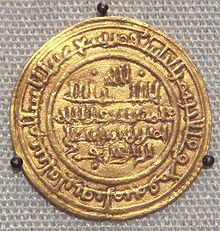 Almoravid gold dinar coin from Seville, Spain, 1116. (British Museum). The Almoravid gold dinar would set the standard of the Iberian maravedi.
Almoravid gold dinar coin from Seville, Spain, 1116. (British Museum). The Almoravid gold dinar would set the standard of the Iberian maravedi.
In 1086 Yusuf ibn Tashfin was invited by the taifa Muslim princes of the Iberian Peninsula (Al-Andalus) to defend them against Alfonso VI, King of León and Castile. In that year, Yusuf ibn Tashfin crossed the straits to Algeciras, inflicted a severe defeat on the Christians at the Battle of az-Zallaqah (Battle of Sagrajas). He was prevented from following up his victory by trouble in Africa, which he had to settle in person.
When he returned to Iberia in 1090, it was avowedly for the purpose of deposing the Muslim princes, and annexing their states. He had in his favour the mass of the inhabitants, who had been worn out by the oppressive taxation imposed by their spend-thrift rulers. Their religious teachers, as well as others in the east, (most notably, al-Ghazali in Persia and al-Tartushi in Egypt, who was himself an Iberian by birth, from Tortosa), detested the native Muslim princes for their religious indifference, and gave Yusuf a fatwa -- or legal opinion—to the effect that he had good moral and religious right, to dethrone the rulers, whom he saw as heterodox and who did not scruple to seek help from the Christians, whose habits he claimed they had adopted. By 1094, he had removed them all, except for the one at Zaragoza; and though he regained little from the Christians except Valencia, he re-united the Muslim power, and gave a check to the reconquest of the country by the Christians.
After friendly correspondence with the caliph at Baghdad, whom he acknowledged as Amir al-Mu'minin ("Commander of the Faithful"), Yusuf ibn Tashfin in 1097 assumed the title of Amir al Muslimin ("Commander of the Muslims"). He died in 1106, when he was reputed to have reached the age of 100.
The Almoravid power was at its height at Yusuf's death, and the Moorish empire then included all North-West Africa as far as Algiers, and all of Iberia south of the Tagus, with the east coast as far as the mouth of the Ebro, and included the Balearic Islands.
Decline
Three years afterwards, under Yusuf's son and successor, Ali ibn Yusuf, Sintra and Santarém were added, and Iberia was again invaded in 1119 and 1121, but the tide had turned, the French having assisted the Aragonese to recover Zaragoza. In 1138, Ali ibn Yusuf was defeated by Alfonso VII of León, and in the Battle of Ourique (1139), by Afonso I of Portugal, who thereby won his crown. Lisbon was recovered by the Portuguese in 1147.
According to some scholars Ali ibn Yusuf was a new generation of leadership that had forgot the desert life for the comforts of the city. [18] Under the combined action of his Christian foes in Iberia and the agitation of Almohads (the Muwahhids) in Morocco. After Ali ibn Yusuf's death in 1143, his son Tashfin ibn Ali lost ground rapidly before the Almohads, and in 1146 he was killed by a fall from a precipice while attempting to escape after a defeat near Oran.
His two successors were Ibrahim ibn Tashfin and Ishaq ibn Ali, but their reigns were short. The conquest of the city of Marrakech by the Almohads in 1147 marked the fall of the dynasty, though fragments of the Almoravids (the Banu Ghaniya), continued to struggle in the Balearic Islands, and finally in Tunisia.
Family names such as Morabito, Murabito and Mirabito are common in western Sicily, the Aeolian Islands and southern Calabria in Italy. These names may have appeared in this region as early as the eleventh century, when Robert Guiscard and the Normans conquered the Muslim emirate of Sicily. In addition to southern Italy, there are also sizable populations of Mourabit (also spelled Morabit, Murabit or Morabet) in modern-day Morocco, Tunisia, Egypt and Mauritania.
Military organization
Abdallah ibn Yassin imposed very strict disciplining measures on his forces for every breach of his laws.[19] The Almoravids' first military leader, Yahya ibn Ibrahim, gave them a good military organization.[20] Their main force was infantry, armed with javelins in the front ranks and pikes behind, which formed into a phalanx;[21][20] and was supported by camelmen and horsemen on the flanks.[21][20] They also had a flag carrier at the front who guided the forces behind him; when the flag was upright the combatants behind would stand and when turned down, they would sit.[21]
al-Bakri reports that, while in combat, the Almoravids did not pursue those who fled in front of them.[21] Their fighting was tense and they did not retreat when disadvantaged by an advancing opposing force and preferred death over defeat.[21] These characteristics were possibly unusual at the time.[21]
List of Almoravid rulers
- Abdallah ibn Yasin (1040–1059)
- Abu-Bakr Ibn-Umar (1061–1087), joint reign
- Yusuf ibn Tashfin (c. 1061–1106), joint reign
- Ali ibn Yusuf (1106–43)
- Tashfin ibn Ali (1143–45)
- Ibrahim ibn Tashfin (1145-1147)
- Ishaq ibn Ali (1147)
Notes
- ^ Extract from Encyclopedia Universalis on Almoravids
- ^ Nehemia levtzion, "Abd Allah b. Yasin and the Almoravids", in: John Ralph Willis, Studies in West African Islamic History, p. 54
- ^ P.F. de Moraes Farias, "The Almoravids: Some Questions Concerning the Character of the Movement", Bulletin de l’IFAN, series B, 29:3-4 (794-878), 1967
- ^ Ibn Abi Zar, p81
- ^ Ibn Abi Zar's account in translated in N. Levtzion and J.F.P. Hopkins, 2000, editors, Corpus of Early Arabic Sources for West African History, University of Ghana, p.239ff. For tentative identification of the ribat, see Moraes Farias (1967)
- ^ Ibn al-Zayyat (1220). التشوف إلى معرفة رجال التصوف [Looking to know the men of Sufism]. pp. 89.
- ^ Qadi Ayyad (12th-century). ترتيب المدارك وتنوير المسالك لمعرفة أعلام مذهب مالك. [Biographies of Eminent Maliki Scholars]. pp. 839-840.
- ^ ʻAbd al-Wāḥid Dhannūn Ṭāhā (1998). The Muslim conquest and settlement of North Africa and Spain. Routledge. ISBN 0415004748. (online at Google Books)
- ^ Mones (1988: p.119; 1992: p.228)
- ^ Lewicki (1988:p.160-61; 1992: p.308-09)
- ^ M.Brett and E. Fentress (1996)The Berbers Oxford: Blackwell, p.100; Revealingly, the 36th Sura begins the salutation "You are one of messengers" and the imperative duty to set people "on the straight path". Ibn Yasin's choice of name was probably not a coincidence.
- ^ a b Shillington, Kevin (2005). History of Africa. 175 5th Avenue, New York, NY, USA: Palgrave Macmillan. p. 88. ISBN 9780333599570.
- ^ Shillington 90
- ^ a b Ibn Abi Zar p87
- ^ a b Ibn Abi Zar, p89
- ^ Muslim Societies in African History (New approaches to African History) David Robinson
- ^ Lange, Dierk (1996). "The Almoravid expansion and the downfall of Ghana", Der Islam 73, pp. 122-159
- ^ North Africa, Islam and the Mediterranean World: From the Almoravids to the Algerian War (History & Society in the Islamic World) pg 59 By Julia Ann Clancy-Smith
- ^ al-Bakri, pp.169-172
- ^ a b c Encyclopædia Britannica (11th ed.). Cambridge University Press
- ^ a b c d e f al-Bakri, p166
References
- Ibn Khaldun, Abderahman (1377). تاريخ ابن خلدون: ديوان المبتدأ و الخبر في تاريخ العرب و البربر و من عاصرهم من ذوي الشأن الأكبر [The history of Ibn Khaldun: Record of the Beginnings and Events in the History of the Arabs and Berbers and their Powerful Contemporaries]. 6. دار الفكر.
- Ibn Abi Zar al-Fassi, Ali Abu al-Hassan (1326). روض القرطاس في أخبار ملوك المغرب و تاريخ مدينة فاس [The Garden of Pages in the Chronicles of the Kings of Morocco and the History of the City of Fes]. Uppsala University.
- al-Bakri (1068). كتاب المسالك و الممالك [Book of the Roads and the Kingdoms]. دار الكتاب الإسلامي, القاهرة.
- Ibn Idhari al-Murakushi, Ahmad (1312). البيان المغرب في أخبار الأندلس والمغرب [Book of the Amazing Story in the Chronicles of the Kings of al-Andalus and Morocco]. جامعة الملك سعود.
- Brett,M. and E. Fentress (1996) The Berbers. Oxford: Blackwell
- Hrbek, I. and J. Devisse (1988) "The Almoravids", in M. Elfasi, editor, General History of Africa, Africa from the Seventh to the Eleventh Century, UNESCO. 1992 ed., Ch. 13, pp. 336–366.
- Lewicki, T. (1988) "The Role of the Sahara and Saharians in relationships between north and south", in M. Elfasi, editor, General History of Africa, Africa from the Seventh to the Eleventh Century, UNESCO. 1992 ed., ch.11, p.276-313.
- Levtzion, N. and J.F.P. Hopkins, editors, (1981) Corpus of Early Arabic Sources for West African History, Cambridge, UK" Cambrdige University Press. 2000 edition.
- Messier,R.A. (2010) Almoravids and the Meanings of Jihad Santa Barbara, Calif.: Praeger.
- Mones, H. (1988) "The conquest of North Africa and Berber resistance", in M. Elfasi, editor, General History of Africa, Africa from the Seventh to the Eleventh Century, UNESCO. 1992 ed.M, Ch. 9, p.224-46.
- Moraes Farias, P.F. de (1967), "The Almoravids: Some Questions Concerning the Character of the Movement", Bulletin de l’IFAN, series B, 29:3-4, pp.794-878.
Preceded by
Idrisid DynastyAlmoravid Dynasty
1040–1147Succeeded by
Almohad Dynasty Morocco topics
Morocco topicsHistory AncientEarly IslamicIdrissid dynasty · Barghawata Confederacy · Kingdom of Nekor · Umayyad Caliphate · Caliphate of CordobaMoroccan dynastiesEuropean influence
(1912-1956)Modern
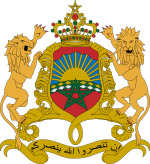
Politics
EconomyGeography Culture Military Demographics Moroccans · Moroccan diaspora · Cities · Languages · Moroccan Arabic · Berber languages · Western SaharaCategories:- Former countries in Africa
- Former empires
- States and territories established in 1040
- States and territories disestablished in 1147
- Dynasties of Morocco
- Muslim dynasties
- Berber dynasties
- Almoravid dynasty
- History of Morocco
- History of Al-Andalus
- History of Algeria
- History of Mauritania
- History of Western Sahara
Wikimedia Foundation. 2010.

